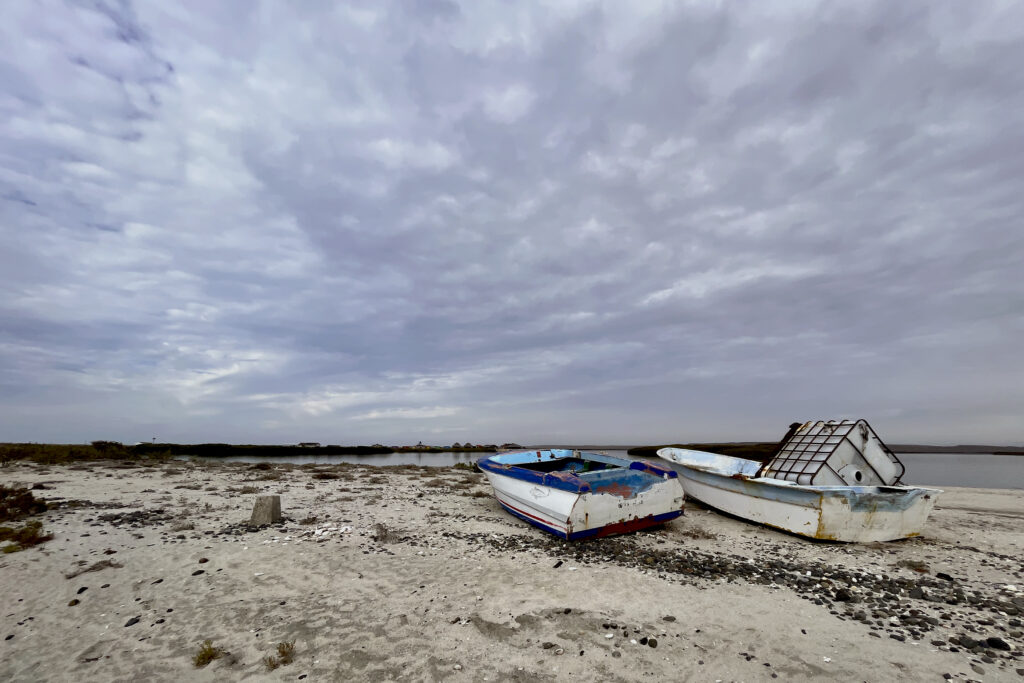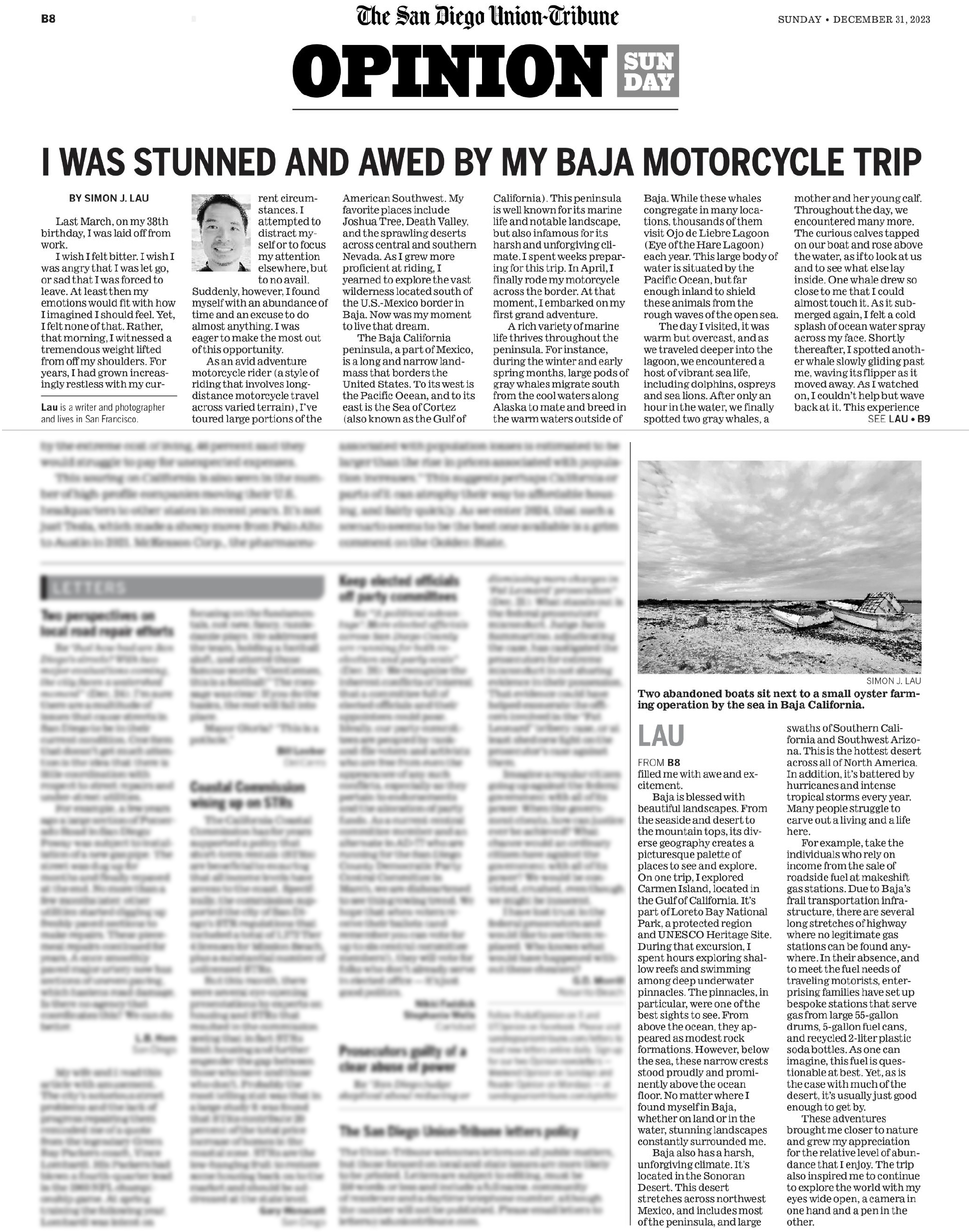December 31, 2023
The San Diego Union-Tribune
I was stunned and awed by my Baja motorcycle trip

By Simon J. Lau
Last March, on my 38th birthday, I was laid off from work.
I wish I felt bitter. I wish I was angry that I was let go, or sad that I was forced to leave. At least then my emotions would fit with how I imagined I should feel. Yet, I felt none of that. Rather, that morning, I witnessed a tremendous weight lifted from off my shoulders. For years, I had grown increasingly restless with my current circumstances. I attempted to distract myself or to focus my attention elsewhere, but to no avail. Suddenly, however, I found myself with an abundance of time and an excuse to do almost anything. I was eager to make the most out of this opportunity.
As an avid adventure motorcycle rider (a style of riding that involves long distance motorcycle travel across varied terrain), I’ve toured large portions of the American Southwest. My favorite places include Joshua Tree, Death Valley, and the sprawling deserts across central and southern Nevada. As I grew more proficient at riding, I yearned to explore the vast wilderness located south of the US-Mexican border in Baja. Now was my moment to live that dream.
The Baja California peninsula, a part of Mexico, is a long and narrow landmass that borders the United States. To its west is the Pacific Ocean, and to its east is the Sea of Cortez (also known as the Gulf of California). This peninsula is well known for its marine life and notable landscape, but also infamous for its harsh and unforgiving climate. I spent weeks preparing for this trip. In April, I finally rode my motorcycle across the border. At that moment, I embarked on my first grand adventure.

A rich variety of marine life thrives throughout the peninsula. For instance, during the winter and early spring months, large pods of gray whales migrate south from the cool waters along Alaska to mate and breed in the warm waters outside of Baja. While these whales congregate in many locations, thousands of them visit Ojo de Liebre Lagoon (Eye of the Hare Lagoon) each year. This large body of water is situated by the Pacific Ocean, but far enough inland to shield these animals from the rough waves of the open sea.


The day I visited, it was warm but overcast, and as we traveled deeper into the lagoon, we encountered a host of vibrant sea life, including dolphins, ospreys, and sea lions. After only an hour in the water, we finally spotted two gray whales, a mother and her young calf. Throughout the day, we encountered many more. The curious calves tapped on our boat and rose above the water, as if to look at us and to see what else lay inside. One whale drew so close to me that I could almost touch it. As it submerged again, I felt a cold splash of ocean water spray across my face. Shortly thereafter, I spotted another whale slowly gliding past me, waving its flipper as it moved away. As I watched on, I couldn’t help but wave back at it. This experience filled me with awe and excitement.



Baja is blessed with beautiful landscapes. From the seaside and desert to the mountain tops, its diverse geography creates a picturesque palette of places to see and explore. On one trip, I explored Carmen Island, located in the Gulf of California. It’s part of Loreto Bay National Park, a protected region and UNESCO Heritage Site. During that excursion, I spent hours exploring shallow reefs and swimming among deep underwater pinnacles. The pinnacles, in particular, were one of the best sights to see. From above the ocean, they appeared as modest rock formations. However, below the sea, these narrow crests stood proudly and prominently above the ocean floor. No matter where I found myself in Baja, whether on land or in the water, stunning landscapes constantly surrounded me.
Baja also has a harsh, unforgiving climate. It’s located in the Sonoran Desert. This desert stretches across northwest Mexico, and includes most of the peninsula, and large swaths of Southern California and Southwest Arizona. This is the hottest desert across all of North America. In addition, it’s battered by hurricanes and intense tropical storms every year. Many people struggle to carve out a living and a life here.

For example, take the individuals that rely on income from the sale of roadside fuel at makeshift gas stations. Due to Baja’s frail transportation infrastructure, there are several long stretches of highway where no legitimate gas stations can be found anywhere. In their absence, and to meet the fuel needs of traveling motorists, enterprising families have set up bespoke stations that serve gas from large 55-gallon drums, 5-gallon fuel cans, and recycled 2-liter plastic soda bottles. As one can imagine, this fuel is questionable at best. Yet, as is the case with much of the desert, it’s usually just good enough to get by.
These adventures brought me closer to nature and grew my appreciation for the relative level of abundance that I enjoy. The trip also inspired me to continue to explore the world with my eyes wide open, a camera in one hand, and a pen in the other.
Tearsheet

Source: The San Diego Union-Tribune



